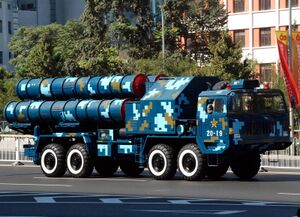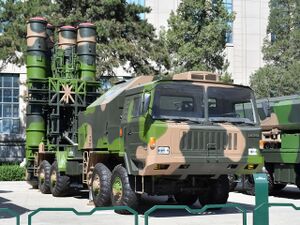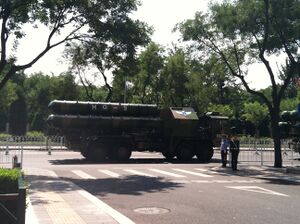HQ-9
| HQ-9 | |
|---|---|
 An HQ-9 portable launcher during China's 60th anniversary parade in 2009, Beijing | |
| النوع | Long-range surface-to-air missile Anti-satellite weapon Anti-ballistic missile |
| مكان الأصل | الصين |
| تاريخ الخدمة | |
| في الخدمة | 2001 – present[1] |
| يستخدمه | See Operators |
| تاريخ الانتاج | |
| الصانع | China Aerospace Science and Industry Corporation[2] |
| المواصفات | |
المدى العملياتي | 120 km (HQ-9)[3] 300 km (HQ-9B)[4][5] |
| سقف الطيران | 50 km (HQ-9B)[5] |
| السرعة | Mach 4+[3] |
نظام التوجيه | Semi-active radar homing[4] |
منصة الإطلاق | HQ-9 ground-launched[6] HHQ-9 surface-launched[3] |
The HQ-9 (الصينية المبسطة: 红旗-9; الصينية التقليدية: 紅旗-9; پنين: Hóng Qí-9; lit. 'Red Banner-9'; NATO reporting name: CH-SA-9.[7]) is a long-range semi-active radar homing (SARH) surface-to-air missile (SAM) developed by the People's Republic of China.[3][4] The naval variant is the HHQ-9 (الصينية المبسطة: 海红旗-9; الصينية التقليدية: 海紅旗-9; پنين: Hǎi Hóng Qí-9; lit. 'Sea Red Banner-9').[3]
Description
The HQ-9 is a derivative of the Russian S-300.[3][4][8] Justin Bronk of the Royal United Services Institute describes the missile as a "hybrid design based on the Russian SA-20 but with radar, seeker head and C2 elements heavily influenced by American and Israeli technology."[8]
The missile uses track-via-missile (TVM) guidance combining inertial guidance, mid-course uplink, and terminal active radar.[9] The TVM used on earlier missiles may have been developed from a United States MIM-104 Patriot missile purchased from Israel or Germany.[6]
According to a 2001 article from Defence International, the HQ-9 is 6.8 m. long with a mass of nearly two tons. The diameters of the first and second stages are 700 mm and 560 mm, respectively. The warhead mass is 180 kg, and the maximum speed is Mach 4.2. The HQ-9 may use fire-control radars from other Chinese SAM systems.[10]
Variants
- Air defense
- HQ-9 — Original variant. NATO reporting name: CH-SA-9.
- HHQ-9 — Naval surface-launched variant.[3] NATO reporting name is CH-SA-N-9.[7]
- HQ-9A — Improved version, first tested in 1999 and service entry in 2001.[1]
- HQ-9B — Improved version with a range of up to 260 km and added passive infrared seeker.[4] Reportedly tested in February 2006.[1] NATO reporting name is CH-SA-21.[7]
- HHQ-9B — Naval surface-launched variant of HQ-9B; NATO reporting name is CH-SA-N-21.[7]
- Ballistic missile defense and anti-satellite
- HQ-19 (NATO reporting name: CH-AB-2)[11] – Anti-ballistic missile variant, reportedly designed to counter medium-range ballistic missiles. It targets ballistic missiles in their midcourse and terminal phases, and it is comparable to the US THAAD.[12] The missile may have "begun preliminary operations" by 2018.[13]
- Export
- FD-2000 – Export variant with a range of 125 km.[6] May be fitted with YLC-20 passive radar against stealthy targets.[14] May use the HT-233 target-acquisition radar,[15] Type 120 low-altitude search radar, and Type 305A AESA search radar.[14]
- FD-2000B – Export variant with a range of 250 km.[1]
- HQ-9P – Custom variant for Pakistan. Range of 125 km for interception against aircraft and around 25 km against cruise missiles.[16][17]
Foreign interest
Turkey
The HQ-9 was a contender in Turkey's T-LORAMIDS program, and it was reportedly selected as the winner in September 2013.[18] The United States responded by blocking funds to integrate the Chinese system into NATO defenses.[19] However, through 2013 there was no confirmation that the deal had been finalized.[20][21][22] In February 2015, the Grand National Assembly of Turkey was informed by the Ministry of National Defence that the evaluation of bids was complete and that the chosen system would be used by Turkey without integration with NATO; the system was not explicitly named. However, other Turkish officials reported that no winner had been selected.[23] Later in the month, Turkish officials revealed that negotiations were ongoing with multiple bidders; the Chinese bid had not yet satisfied requirements concerning technology transfer.[24] In March 2015, a China Daily article reported that it was "well-known that the Chinese FD-2000 system, a HQ-9 model for export, was chosen for the contract with Turkey in 2013" based on comments made by a CPMIEC representative at the 2015 Langkawi International Maritime and Aerospace Exhibition; the article was misleadingly called "Missile sale to Turkey confirmed."[25] In November 2015, Turkey confirmed it would not purchase the HQ-9, opting for an indigenously developed system instead.[26]
Operating history
China
China has deployed HQ-9s near or in disputed territory. Missiles were deployed in July 2015 to Hotan in Xinjiang, close to Kashmir across the Line of Actual Control,[27] and in February 2016 to Woody Island in the disputed South China Sea.[28][29]
Pakistan
The Pakistan Army operates the HQ-9/P variant.[17] Negotiations for the purchase of the HQ-9 and HQ-16 by Pakistan began in early 2015.[30] The system officially entered service on October 14, 2021.[17]
المشغلون
- People's Liberation Army Air Force - 196 HQ-9, 96 HQ-9B as of 2024[31]
- Royal Moroccan Army - Four batteries of FD-2000B purchased in 2016. The first battery was expected to be delivered in 2020 or 2021.[32]
- Egyptian Air Defense Forces - In 2025, Middle East Monitor reported that, according to Israeli media, Egypt had received the HQ-9B.[36][بحاجة لمصادر إضافية]
- Iranian Armed Forces - A report from July 2025 claimed, citing unnamed Arab officials, that Iran received Chinese surface-to-air missile systems in exchange for oil after the Iran-Israel war.[37]
See also
- Similar systems
- HQ-22
- Terminal High Altitude Area Defense
- MIM-104 Patriot
- S-300 (missile)
- Medium Extended Air Defense System
- Project Kusha
- Aster
- David's Sling
- Barak 8
- Related lists
References
Citations
- ^ أ ب ت "HQ-9/-15, and RF-9 (HHQ-9 and S-300) (China), Defensive weapons". Jane's Information Group. 7 يناير 2010. Archived from the original on 3 مايو 2012.
- ^ Grevatt, Jon (11 فبراير 2016). "China's CASIC targets international expansion". Janes. Retrieved 11 ديسمبر 2021.
- ^ أ ب ت ث ج ح خ McCabe, Thomas R. (23 مارس 2020). "Air and Space Power with Chinese Characteristics: China's Military Revolution" (PDF). Air & Space Power Journal. 34 (1): 28. Retrieved 11 ديسمبر 2021.
- ^ أ ب ت ث ج Dahm (March 2021): page 6
- ^ أ ب Chen, Chuanren (2 أغسطس 2017). "China Shows New Fighters, Missiles and Drones". AINonline. Retrieved 16 مايو 2022.
- ^ أ ب ت Fisher, Richard D Jr (11 فبراير 2016). "China deploys HQ-9 surface-to-air missiles to Woody Island". Archived from the original on 20 فبراير 2016. Retrieved 11 ديسمبر 2021.
- ^ أ ب ت ث "Chapter Five: Asia: Regional trends in 2024". The Military Balance 2025. 125 (1): 206–311. 2025. doi:10.1080/04597222.2025.2445477.
- ^ أ ب Bronk, Justin (January 2020). Modern Russian and Chinese Integrated Air Defence Systems: The Nature of the Threat, Growth Trajectory and Western Options. Royal United Services Institute. p. 20. Archived from the original. You must specify the date the archive was made using the
|archivedate=parameter. https://rusi.org/explore-our-research/publications/occasional-papers/modern-russian-and-chinese-integrated-air-defence-systems-nature-threat-growth-trajectory-and/. Retrieved on 11 December 2021. - ^ "Hong Qi 9 (HQ-9) Air Defence Missile System". Army Technology. 28 مايو 2021.
- ^ 「黃河」 (يناير 2001). "巡天神箭 紅旗9號與紅旗家族動態". Defence International (114): 72–81.
- ^ Trevithick, Joseph (4 فبراير 2021). "China Claims It Has Conducted A New Midcourse Intercept Anti-Ballistic Missile Test". The Drive.
- ^ Saunders, Phillip C. (10 يونيو 2021). "Testimony before the U.S.-China Economic and Security Review Commission Hearing on China's Nuclear Forces" (PDF). U.S.-China Economic and Security Review Commission. Retrieved 11 ديسمبر 2021.
- ^ United States Office of the Secretary of Defense (2018). Annual Report To Congress: Military and Security Developments Involving the People's Republic of China 2018.. p. 60. Archived from the original. You must specify the date the archive was made using the
|archivedate=parameter. https://media.defense.gov/2018/Aug/16/2001955282/-1/-1/1/2018-CHINA-MILITARY-POWER-REPORT.PDF. Retrieved on 11 December 2021. - ^ أ ب Hasik, James (2 أكتوبر 2013). "Chinese Anti-Aircraft Missiles for Turkey? Some Implications for Security and Industry". Atlantic Council. Retrieved 11 ديسمبر 2021.
- ^ أ ب Cranny-Evans, Samuel (22 نوفمبر 2019). "Uzbekistan conducts first FD-2000 air-defence test". Janes. Retrieved 11 ديسمبر 2021.
- ^ Usman Ansari (27 مارس 2024). "Pakistan unveils aircraft and rocket programs, parades military tech". Retrieved 10 أبريل 2024.
- ^ أ ب ت ث Cranny-Evans, Samuel; Dominguez, Gabriel (15 أكتوبر 2021). "Pakistan Army commissions HQ-9/P air-defence system". Janes. Retrieved 11 ديسمبر 2021.
- ^ Toksabay, Ece (26 سبتمبر 2013). "Chinese firm wins Turkey's missile defense system tender". reuters.com. reuters. Retrieved 26 سبتمبر 2013.
- ^ Wilson, Steve (14 ديسمبر 2013). "Congress to block Turkey using US funds to buy missile system from blacklisted Chinese firm". telegraph.co.uk. AFP. Retrieved 14 ديسمبر 2013.
- ^ Lague, David (2 أكتوبر 2013). "For China, Turkey missile deal a victory even if it doesn't happen". Reuters.
- ^ Daloglu, Tulin (27 سبتمبر 2013). "Turkey close to deal with China for anti-missile system". Al-Monitor.
- ^ "Update: Turkey Remains Defiant About Co-Producing Missile Defense System with China". Defense Update. 25 أكتوبر 2013.
- ^ Karadeniz, Tulay (19 فبراير 2015). "Turkey eyes deal with China on missile defense despite NATO concern". Reuters. Retrieved 12 مايو 2015.
- ^ Coskun, Orhan; Karadeniz, Tulay (26 فبراير 2015). "Turkey goes back to other missile system bidders as China drags feet: officials". Reuters. Retrieved 12 مايو 2015.
- ^ Peng, Yining (19 مارس 2015). "Missile sale to Turkey confirmed". China Daily. Retrieved 12 مايو 2015.
- ^ Butler, Daren; Karadeniz, Tulay; Martina, Michael (18 نوفمبر 2015). Mark, Heinrich (ed.). "UPDATE 2-Turkey confirms cancellation of $3.4-bln missile defence project awarded to China". Reuters. Retrieved 25 نوفمبر 2015.
- ^ "PLA sends HQ-9 air defense missiles close to Kashmir border". Want China Times. 6 يوليو 2015. Archived from the original on 6 أكتوبر 2015. Retrieved 2 أغسطس 2015.
- ^ "China 'has deployed missiles in South China Sea' - Taiwan". BBC News. 17 فبراير 2016.
- ^ "U.S. expects 'very serious' talks with China after missile reports". Reuters. 17 فبراير 2016 – via www.reuters.com.
- ^ "Pakistan first to China's table for HQ-9, HQ-16 missile systems". Want China Times. 2 أبريل 2015. Archived from the original on 16 يوليو 2015. Retrieved 2 أغسطس 2015.
- ^ The Military Balance 2024. International Institute for Strategic Studies. p. 260.
- ^ Halimi, Mohammed (26 يونيو 2020). "Marruecos a punto de recibir su primer sistema de defensa aérea de largo alcance". Defensa.com (in الإسبانية). Retrieved 26 يونيو 2020.
- ^ International Institute for Strategic Studies 2020, p. 211.
- ^ International Institute for Strategic Studies 2020, p. 216.
- ^ (in en)Hum Arze Pak Key Hawai Fauj K Uqaab, 11 March 2022, https://www.youtube.com/watch?v=3H7wGfpS68s, retrieved on 2022-03-11
- ^ "Egypt has Chinese air defence system similar to Russia's S-400, say Israeli reports". 16 أبريل 2025.
- ^ Mathews, Sean (7 يوليو 2025). "Iran receives Chinese surface-to-air missile batteries after Israel ceasefire deal". Middle East Eye. Retrieved 11 يوليو 2025.
Sources
- Dahm, J. Michael (March 2021). Offensive and Defensive Strike. South China Sea Military Capabilities Series. Johns Hopkins University Applied Physics Laboratory. Archived from the original. You must specify the date the archive was made using the
|archivedate=parameter. https://www.jhuapl.edu/Content/documents/OffensiveDefensiveStrike.pdf. Retrieved on 11 December 2021. - International Institute for Strategic Studies (15 فبراير 2020). The Military Balance 2020. London, England: Routledge. ISBN 978-0-367-46639-8.
وصلات خارجية
- HQ-9 missile launch photos, Chinese Air Force Archived 10 أبريل 2016 at the Wayback Machine AirForceWorld.com
- FD-2000 long range air defense missile system(Army recognition)
- HQ-9 medium-to-long range air defense missile system(Army recognition)
- HQ-9 / FT-2000 SAM Sinodefence
- Naval HQ-9 SAM Sinodefence
- HQ-9 Missilethreat.com
- CHINA OFFERS FD-2000 / HQ-9, FK-1000 AND FL-3000N MISSILE SYSTEMS TO THAILAND 6 November 2013
- CS1 الإسبانية-language sources (es)
- Short description is different from Wikidata
- Use dmy dates from December 2020
- Articles containing simplified Chinese-language text
- Articles containing traditional Chinese-language text
- جميع المقالات بحاجة لمصادر إضافية
- مقالات بحاجة لمصادر إضافية from July 2025
- Missile defense
- Surface-to-air missiles of the People's Republic of China
- Weapons of the People's Republic of China
- Naval surface-to-air missiles
- Anti-ballistic missiles of the People's Republic of China
- Military equipment introduced in the 1990s



